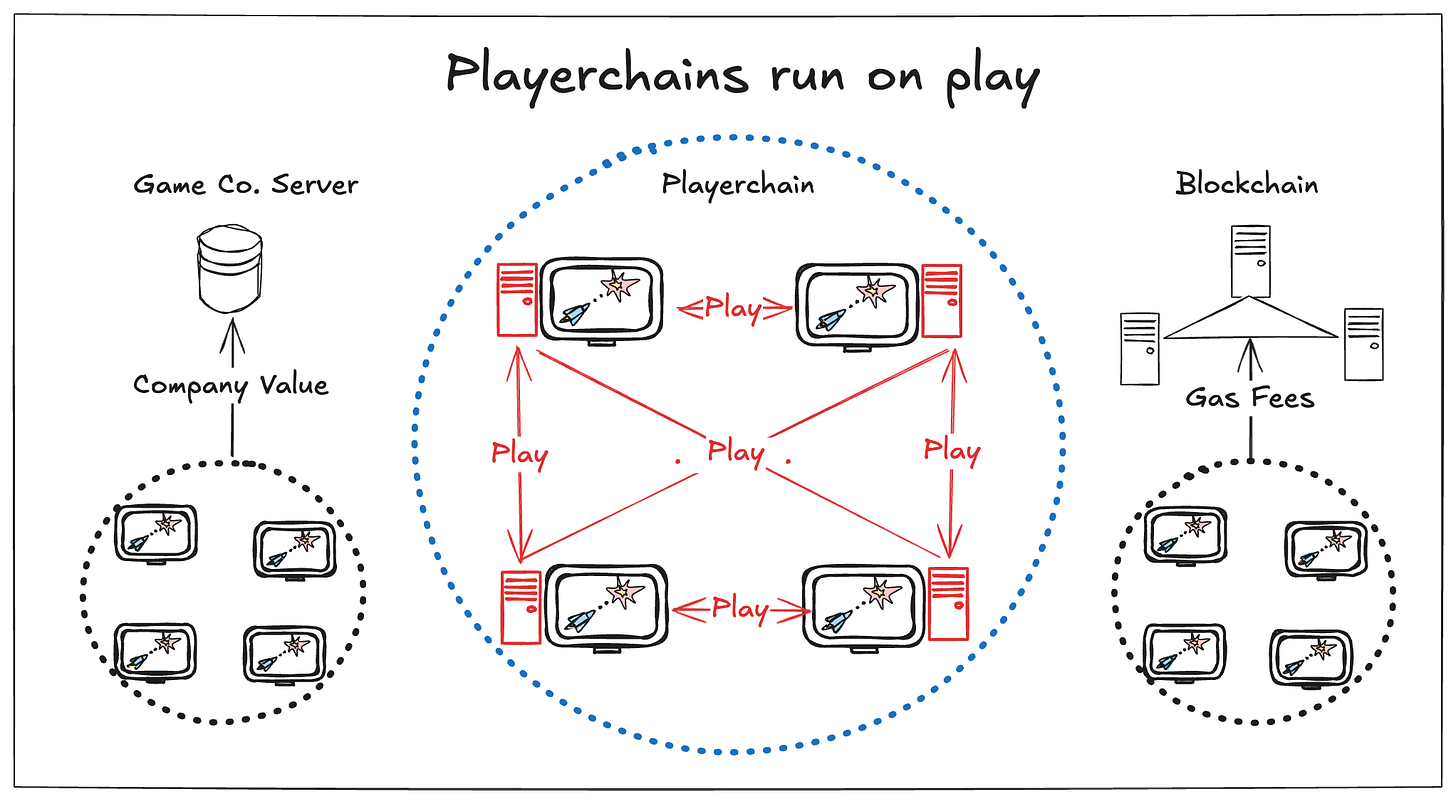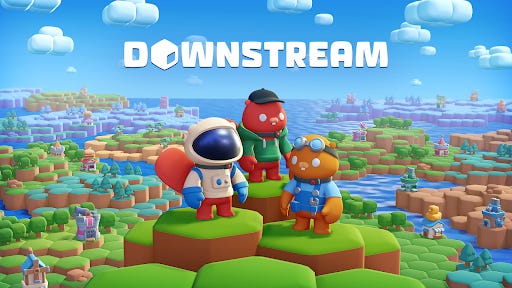Why we need Playerchains
Ditching the Degens
For a few years now, Playmint has been using blockchains to create new types of games.
We’re experienced game developers that, unlike our games industry peers, want to see more games that are free from centralised control. This led us to working on fully onchain games (FOCGs), as a quite extreme form of decentralisation, and we have hard-earned insights into the technical and game design solutions needed to make these games work. However, there is an inescapable truth for blockchain games: the link with real money results in a very narrow type of fun. This isn’t play. At least, not the kind of play typical gamers want.
Our latest technical solution, playerchains, not only addresses the practical difficulties of FOCGs, but crucially unlocks a path to making decentralised games that are for playing, not speculating.
All blockchains are not created equally
The choice of blockchain for the “onchain” part of a fully onchain game is significant. The default choice is a public (i.e. permissionless) blockchain, but we argue that permissioned blockchains are actually a better fit for games.
Many teams, including Playmint, have tried to put games on public blockchains without explicitly financialised gameplay. However, blockchains are inherently interoperable financial systems. Any game on that chain is inescapably connected to money. And that connection creates an opportunity for people to leverage the game in service of financial speculation. Frequently, this activity eclipses play of the underlying game. Some have argued that this is a new type of fun, and the whole point of FOCGs. But if you want to make games with a focus on play, you need a different solution. Games on a permissioned chain, where no money exists in the first place, retain play as the dominant activity.
Playerchain Architecture
Playerchain is a peer-to-peer network architecture for running highly responsive multiplayer games. It is a permissioned, DAG-based blockchain, where the players run game code and consensus code in the same client.
Company-owned servers are incentivised to run as long as the company is profitable. Blockchains are incentivised to run as long as nodes make money. Playerchains run as long as players want to play. Read more about the playerchain architecture here.
In addition to being a player-centric architecture, playerchains also solve core practical difficulties for creators working with FOCGs, such as access to real-time multiplayer, familiar tick-based game development, and gasless transactions.
Creators can design connections to wider ecosystems that include public blockchains and a wider lattice of playerchains, thereby retaining the cool properties of games on public blockchains like interoperability and permissionless composability.
Playerchain Demo
To demonstrate the power of playerchains, we’ve built a space shooter game as a brief proof of concept.
Anyone can download the game, start a playerchain with some friends, and play a real-time responsive game with no servers involved.
For now, you’ll have to review the code yourself or take us at our word that all player actions are on immutable chains, but it will be possible to demonstrate this more clearly in future.
Lessons from an Autonomous World
Before starting work on playerchains, Playmint deployed an early version of Downstream, our fully onchain UGC platform, to the Ethereum L2, Redstone (a public blockchain).
It's a working example of an Autonomous World (AW), a compelling idea for digital worlds that run without owners and allow participants to build emergent experiences on top of the world’s immutable digital physics.
We exposed the technical composability of an AW that’s built fully onchain with no-code creator tools that enabled anyone to build games within Downstream. Many people have deployed their only ever smart contracts through these tools, which demonstrates that user generated content is possible in a fully onchain game. More advanced creators have built a variety of experiences like PvP games, puzzle adventures, and interoperability with other Redstone games. Creators demonstrated the unpredictable innovation enabled by a permissionlessly composable world on a publicly interoperable network.
However, the creators needed a push to create, and Downstream was not an instantly thriving Autonomous World. Despite some exciting technical innovations to make Downstream a welcoming place for creators, it was falling short. Identifying the practical issues of making Autonomous Worlds as a Fully On (Public) Blockchain platform, and understanding the shortfalls of other solutions has led us to playerchains.
Persistence and Composability: A Global Lattice of Playerchains
Despite being “user-agnostic unstoppable machines churning crypto money” (to quote guiltygyoza in his excellent vision for human centric networks powered by CRDTs), public blockchains are still good at some things that should benefit games: ownership, persistence, interoperability, and enabling permissionless worlds with thousands of players.
Coloured patches represent playerchains as partial views of a global blocklace that enables persistence and connections.
Playerchains do not shut the door to public blockchain connections. Smart contracts could grant awards after a playerchain session because all actions are signed and verifiable. More interestingly, playerchains open the door to a player-centric set of interconnected worlds. Each player forms their own immutable history and as groups form playerchains, they are sharing partial views of a global blocklace containing all of their histories. This enables worlds to persist and an emergent lattice of interconnected players and games.
A world committed to a public blockchain is persistent and composable by default, but comes at the cost of interacting with real money. A world formed in a playerchain is private by default and sleeps when the players stop playing. This is the correct default for games and the right starting place for persistent and connected worlds.
Conclusion - Let's make games for playing
It’s time to accept that public blockchain games are for degens.
These games serve a small number of dedicated speculators and that unhealthy part of our brains that secretly hopes to get rich quick. This was the sad truth of the first wave of play-to-earn games and nothing has really changed with fully onchain games, The Autonomous Worlds meme seemed to suggest an alternative, but in practice anything built on a public blockchain has the same issues.
The $200 billion games market exists because people want to play. Games innovation is stifled because a few corporations have maximised power and minimised the value of creative talent. Blockchain is an incredible technology that could disrupt the status quo by allowing coordination without authority and value transfer without banks.
Playerchain is a blockchain technology that removes centralised parties while focusing on the experience of play. Let’s use blockchain to unlock the system, reward the talent, and generate a new wave of games for everyone. Not just the degens.
Thank you to lots of people for corrections, encouragement and pushback:
asteure, Baz, Brief_Kandle, Goblin, guiltygyoza, Ken Anderson, Loaf, loothero, Martin Maurer, Matt Dion, Stokarz, Sylve








